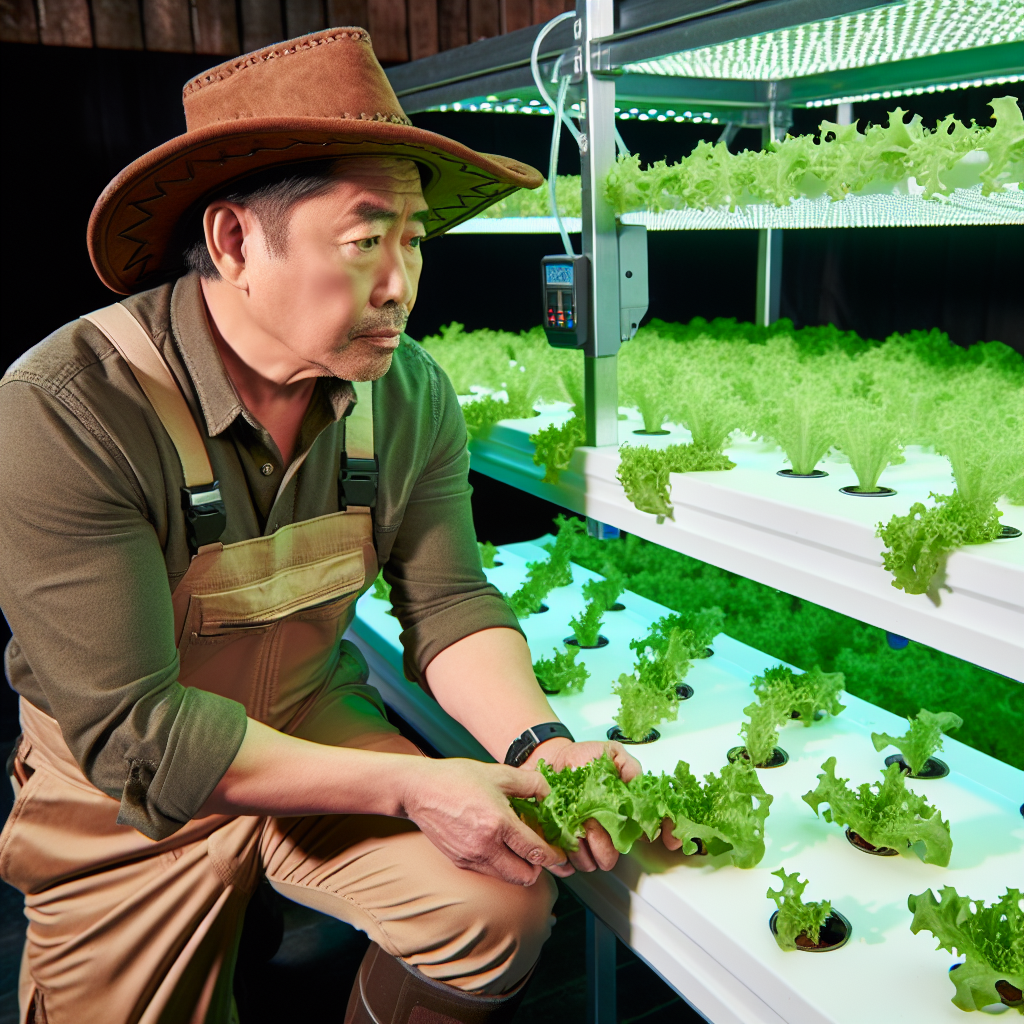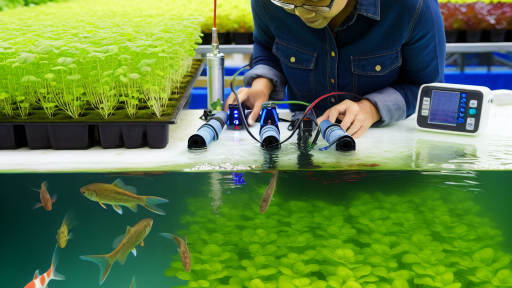Overview of Hydroponics
Definition of Hydroponics
Hydroponics is a method of growing plants without soil.
Instead, it uses nutrient-rich water to deliver essential elements.
This technique allows for greater control over plant growth.
Farmers can manage nutrients, pH levels, and moisture precisely.
Importance in Modern Agriculture
Hydroponics plays a vital role in increasing food production.
This technique allows farming in urban areas with limited space.
Additionally, it reduces the need for pesticides and herbicides.
Consequently, this method promotes healthier food options.
Moreover, hydroponics conserves water compared to traditional farming.
This conservation is crucial in regions facing water scarcity.
Advantages of Hydroponics
Hydroponics enables faster plant growth rates.
Plants grow up to 50% faster than in soil-based systems.
Furthermore, hydroponics increases crop yield per square foot.
As a result, farmers maximize their production capacity.
Additionally, it minimizes the risk of soil-borne diseases.
Transform Your Agribusiness
Unlock your farm's potential with expert advice tailored to your needs. Get actionable steps that drive real results.
Get StartedChallenges of Hydroponics
While beneficial, hydroponics presents specific challenges.
Initial setup costs can be high compared to traditional methods.
Farmers must also understand the technical aspects of the system.
Continuous monitoring is necessary to maintain optimal conditions.
Moreover, any system failure can lead to rapid crop loss.
Types of Hydroponic Systems
Nutrient Film Technique
The Nutrient Film Technique (NFT) is a popular hydroponic method.
This system circulates a thin film of nutrient solution over plant roots.
It ensures that the roots receive adequate oxygen and nutrients.
Moreover, NFT minimizes water usage compared to traditional systems.
Farmers often use NFT for growing leafy greens and herbs.
Deep Water Culture
Deep Water Culture (DWC) is another effective hydroponic system.
This method involves suspending plants in nutrient-rich water.
Air stones provide oxygen to the roots in this setup.
Consequently, plants grow rapidly and demonstrate high yields.
DWC is ideal for crops like lettuce and other fast-growing plants.
Aeroponics
Aeroponics is an innovative technique gaining popularity.
This system suspends plants in air and mists them with nutrients.
It promotes exceptional growth rates and resource efficiency.
Aeroponics requires less water than soil-based methods.
Farmers can grow a variety of crops in constrained spaces using this technique.
Other Hydroponic Systems
Several other hydroponic systems exist, catering to various needs.
- Drip Systems deliver nutrient solution directly to plants.
- Wick Systems use capillary action to move nutrients to plants.
- Vertical Hydroponics maximizes space by stacking plants vertically.
Each technique has unique benefits and suitable applications.
Farmers should consider their specific requirements and resources.
Advantages of Hydroponic Farming
Water Efficiency
Hydroponic farming significantly reduces water usage compared to traditional methods.
Showcase Your Farming Business
Publish your professional farming services profile on our blog for a one-time fee of $200 and reach a dedicated audience of farmers and agribusiness owners.
Publish Your ProfileThis method allows for up to 90% less water consumption.
It utilizes a closed-loop system, minimizing waste and evaporation.
Farmers can monitor and adjust water levels easily for optimal plant growth.
Consequently, this technique is crucial in regions facing water scarcity.
With hydroponics, water is recirculated, leading to conservation and sustainability.
Space Optimization
Hydroponic systems maximize space utilization for crop production.
Vertical farming allows growers to produce more food in smaller areas.
This approach benefits urban farming by using rooftop gardens and basements.
Additionally, crops grow faster and healthier in more controlled environments.
Optimized spacing can increase yields substantially per square foot.
As a result, farmers can produce food where traditional methods may not be viable.
Year-Round Crop Production
Hydroponics enables continuous crop production throughout the year.
Farmers are not restricted by seasonal changes or adverse weather conditions.
This flexibility allows for multiple harvests in a single year.
Controlled conditions support stable plant growth and reduce disease risk.
Consequently, year-round production meets the growing food demand effectively.
Furthermore, it contributes to food security in various regions.
Delve into the Subject: Heirloom Gardening Tools Every Farmer Needs
Innovative Technologies in Hydroponics
Automated Systems
Automation revolutionizes hydroponic farming.
It reduces the need for manual labor and increases efficiency.
Farmers can set up automated nutrient delivery systems.
These systems ensure optimal growth conditions for plants.
Additionally, automated lights enhance growth cycles based on plant needs.
Sensors
Sensors play a crucial role in modern hydroponics.
They monitor temperature, humidity, and nutrient levels in real-time.
Farmers receive alerts when conditions deviate from optimal ranges.
Moreover, sensors can measure pH levels in nutrient solutions.
This information helps in making informed decisions quickly.
IoT Integration
The Internet of Things connects various hydroponic systems.
Farmers can control systems remotely via smartphones or computers.
This capability leads to more precise interventions as needed.
Farmers can analyze data from multiple sources to improve yields.
Ultimately, IoT integration enhances decision-making processes.
Benefits of Innovative Technologies
Incorporating technology streamlines operations for farmers.
- Increased productivity due to efficient resource management.
- Reduced labor costs through automation and remote management.
- Improved plant health through precise monitoring and adjustments.
- Access to real-time data that supports quick decision-making.
These advancements position hydroponic farmers for future success.
Explore Further: Essential Nutrients for Hydroponic Growth
Sustainable Practices in Hydroponics
Organic Nutrient Solutions
Organic nutrient solutions play a crucial role in hydroponics.
They enhance plant growth while ensuring environmental safety.
Farmers can utilize compost teas and worm castings for optimal nutrients.
These solutions reduce reliance on synthetic fertilizers.
Showcase Your Farming Business
Publish your professional farming services profile on our blog for a one-time fee of $200 and reach a dedicated audience of farmers and agribusiness owners.
Publish Your ProfileAdditionally, they promote healthier plants and improve taste.
Using organic methods supports a sustainable cycle within agriculture.
Renewable Energy Sources
Integrating renewable energy sources is vital for sustainable hydroponics.
Solar panels provide an efficient energy solution for hydroponic systems.
Farmers can leverage wind turbines to reduce operational costs.
By utilizing renewable energy, farmers lower their carbon footprint.
Furthermore, this approach ensures energy independence for growers.
Investing in energy-efficient technologies enhances overall productivity.
You Might Also Like: Protecting Heirloom Varieties from Pests

Case Studies of Successful Hydroponic Farms
Introduction to Hydroponic Success Stories
This section highlights notable hydroponic farms.
These case studies reflect innovation and adaptability.
Learning from industry leaders helps new farmers.
GreenLeaf Hydroponics: A Pioneering Example
GreenLeaf Hydroponics stands out in urban farming.
Located in Chicago, it utilizes vertical farming techniques.
This farm produces high yields in limited space.
Additionally, they focus on organic methods and sustainable practices.
Their success demonstrates the potential for urban agriculture.
Key Strategies Employed
- Integration of aeroponic systems for rapid growth.
- Advanced nutrient solutions tailored to each crop.
- Use of renewable energy to power operations.
FreshHarvest Farms: A Community-Centric Approach
FreshHarvest Farms is based in North Carolina.
This farm emphasizes community engagement and education.
They host workshops to teach hydroponic techniques.
Moreover, they supply local restaurants with fresh produce.
Their model promotes both sustainability and economic growth.
Lessons Learned from FreshHarvest
- Building partnerships enhances community support.
- Education drives local interest in hydroponics.
- Engaging consumers leads to strong brand loyalty.
Leaf & Co: Innovations in Crop Variety
Leaf & Co specializes in diverse crop production.
They grow exotic herbs and vegetables using hydroponics.
This variety attracts niche markets and specialty stores.
By adopting controlled environment agriculture, they ensure consistency.
Their innovative growing schedule maximizes output year-round.
Innovation Techniques at Leaf & Co
- Experimentation with rare and high-value crops.
- Application of data analytics for crop management.
- Utilization of hydroponic seedling propagation systems.
Hydroponics as a Viable Solution
Each case study reveals distinct pathways to success.
Sustainability, community engagement, and innovation are common themes.
Learning from these leaders can inspire aspiring farmers.
Hydroponics presents a viable solution for modern agriculture.
Discover More: Enhancing Biodiversity with Heirloom Varieties
Challenges and Solutions in Hydroponic Farming
Pest Management
Pest management poses a significant challenge in hydroponic farming.
Farmers must develop effective strategies to prevent infestations.
One solution involves using integrated pest management (IPM) techniques.
Beneficial insects, such as ladybugs, can naturally control pests.
Implementing regular monitoring also helps identify potential issues early.
Farmers can utilize organic pesticides as an additional preventive measure.
Moreover, employing physical barriers can protect crops from pests.
Disease Control
Controlling diseases in hydroponic systems requires diligence and knowledge.
Showcase Your Farming Business
Publish your professional farming services profile on our blog for a one-time fee of $200 and reach a dedicated audience of farmers and agribusiness owners.
Publish Your ProfileWaterborne diseases can spread quickly in nutrient solutions.
Frequent water testing ensures a healthy environment for plants.
Farmers can adopt sterilization methods to eliminate pathogens.
Utilizing resistant plant varieties also offers a proactive approach.
Crop rotation and diversification can further reduce disease risks.
Regularly cleaning equipment contributes to minimizing disease transmission.
Economic Viability
Economic viability remains a crucial consideration for hydroponic farmers.
Initial setup costs can be high, impacting profitability.
Investing in automation helps reduce long-term labor costs.
Additionally, crop selection plays a vital role in maximizing revenue.
Growing high-demand crops can boost financial returns significantly.
Participating in local farmers’ markets can increase visibility and sales.
Furthermore, securing grants and funding can ease financial burdens.
Future Trends in Hydroponics
Vertical Farming
Vertical farming optimizes space utilization in urban environments.
This method allows for greater production per square foot.
Farmers can grow crops in stacked layers, enhancing yield.
Additionally, vertical farms typically use controlled environments.
This control improves plant growth and reduces pests significantly.
Moreover, vertical farming relies on LED lighting for photosynthesis.
LED technology reduces energy consumption compared to traditional methods.
Innovative hydroponic systems in vertical farms are versatile.
They include nutrient film techniques and aeroponics.
These systems can adapt to various crops and growth stages.
Bioponics
Bioponics integrates living organisms into hydroponic systems.
This method enhances nutrient availability and plant health.
Microorganisms help break down nutrients for better absorption.
Bioponics promotes symbiotic relationships in the growing environment.
Farmers can explore various microbial solutions for optimal results.
Furthermore, this technique reduces reliance on synthetic fertilizers.
As a result, bioponics supports more sustainable farming practices.
Many researchers are exploring new bioponic methods today.
These innovations focus on improving crop resilience and yield.
Advancements in Genetic Engineering
Genetic engineering is reshaping the future of hydroponics.
Crops can be modified for enhanced growth and disease resistance.
These advances lead to higher yields and efficient resource use.
Additionally, scientists are developing plants with specific nutrient profiles.
Farmers can grow crops that meet particular dietary needs.
The integration of CRISPR technology enables precise modifications.
As a result, genetic engineering opens doors for innovation.
Experts predict that tailored crops will become the norm.
Showcase Your Farming Business
Publish your professional farming services profile on our blog for a one-time fee of $200 and reach a dedicated audience of farmers and agribusiness owners.
Publish Your ProfileFurthermore, these advancements could revolutionize food security.
Additional Resources
Is Vertical Farming a Good Idea? No. It’s largely, though not entirely …




